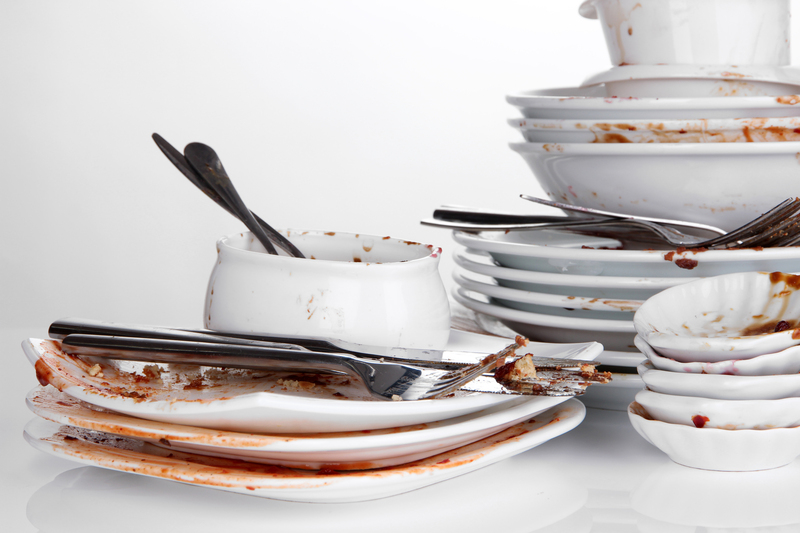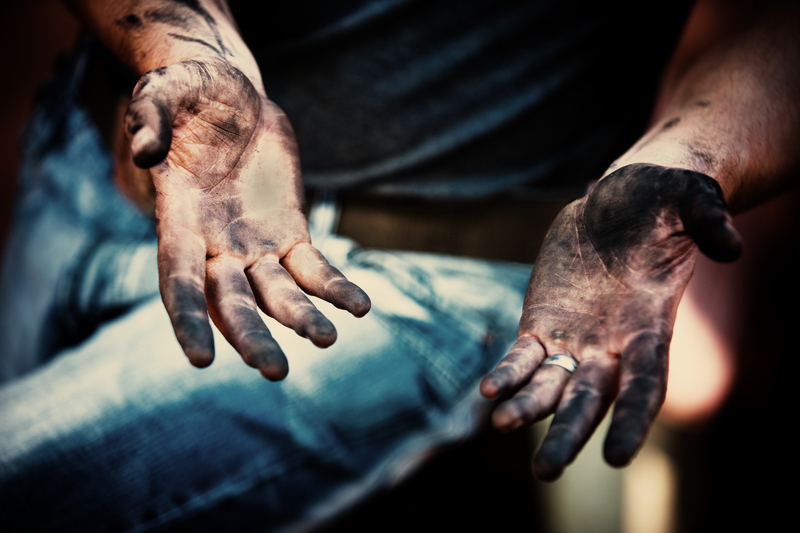Discover the Best Ways to Clean Burnt-on Residue
Posted on 21/08/2025
Discover the Best Ways to Clean Burnt-on Residue
Have you ever faced the daunting task of scrubbing away burnt-on residue from pots, pans, or baking trays? If so, you know how stubborn and time-consuming it can be! Fortunately, there are effective techniques and powerful cleaning solutions you can employ to restore your cookware and appliances to their sparkling best. In this comprehensive guide, we'll walk you through the most efficient and proven methods for cleaning burnt-on residue, sharing expert tips and tricks for kitchens of all shapes and sizes.
Understanding Burnt-on Residue
Before diving into the best ways to clean burnt-on residue, it's essential to understand what causes it in the first place. Burnt residue typically occurs when food, grease, or sauces are exposed to high heat for extended periods, leading to a layer of carbonized material that clings stubbornly to surfaces. This is especially common on stainless steel pans, glass cookware, ovens, and stovetops.
Burnt food doesn't just look unappealing--it can impact the flavor of future meals and even cause long-term damage if not addressed promptly. Whether you're a novice cook or an experienced chef, learning how to clean burnt-on food efficiently will save you time and preserve your valuable cookware.

Essential Tools and Supplies
Before you start, gather the following cleaning tools and ingredients commonly recommended for tackling burnt-on residue:
- Non-abrasive scrubbers or sponges
- Baking soda
- White vinegar
- Lemon juice
- Plastic or wooden spatulas (for gentle scraping)
- Dish soap
- Hot water
- Commercial burnt-on residue cleaners (as a last resort)
- Gloves (to protect your hands)
Most methods rely on everyday household items, so you rarely need to invest in expensive specialized cleaners. Let's now explore the best methods for removing burnt-on residue from various surfaces.
Top Methods to Clean Burnt-on Residue
1. The Soak-and-Scour Method
Simply soaking cookware in hot, soapy water is often the first step in the battle against burnt-on food. This method is easy, gentle, and highly effective on mild to moderate residue on most cookware.
- Fill the affected pan or dish with hot water and a generous squirt of dish soap.
- Let it soak for at least 30 minutes, or overnight for stubborn stains.
- Use a non-abrasive sponge or scrubbing pad to lift away the softened residue.
- Repeat the process if necessary, being careful not to scratch delicate surfaces.
Tip: For non-stick cookware, avoid steel wool or harsh scouring pads, which can damage the non-stick coating.
2. Baking Soda & Vinegar Power
Baking soda and white vinegar are a dynamic duo for removing burnt-on residue thanks to their chemical reaction, which helps to loosen and break apart even the toughest stains.
- Sprinkle a generous layer of baking soda onto the burnt area, covering it completely.
- Pour a small amount of white vinegar over the baking soda. The mixture will fizz and bubble.
- Let the reaction sit for 10-15 minutes to penetrate the residue.
- Scrub gently with a sponge or scrubber, adding more vinegar if necessary.
- Rinse thoroughly with hot water.
This method is especially effective for cleaning burnt stainless steel pans, oven trays, and stovetop stains. It's natural, non-toxic, and safe for most surfaces.
3. Boil and Lift Clean Technique
For tough, burnt layers on pans and pots, try using the power of heat. The "boil and lift" method works wonders on stubborn residue while minimizing physical labor.
- Fill the burnt pot with enough water to cover the residue.
- Add 1-2 tablespoons of baking soda or dish soap.
- Bring the solution to a boil on the stove, then simmer for 10-15 minutes.
- Turn off the heat and allow the water to cool slightly.
- Gently scrape and scrub away loosened residue with a wooden or plastic spatula.
Warning: Never pour cold water into a hot pan or vice versa--this can cause warping, especially with glass or ceramic cookware.
4. Lemon Power for Shine and Freshness
Lemon's natural acidity offers a fresh, chemical-free method to tackle burnt-on residue, particularly for glassware and microwaves, leaving behind a pleasant citrus aroma.
- Slice a lemon and rub it directly onto the burnt area, squeezing out juice as you scrub.
- Alternatively, combine lemon juice with baking soda for extra cleaning power.
- Let the mixture sit for 15 minutes, then buff away with a damp cloth or sponge.
- Rinse and dry as usual.
Lemon can also deodorize and disinfect, making it ideal for kitchen appliances and cutting boards.
5. Commercial Cleaners for Extreme Stains
If home remedies fail, there's a wide selection of commercial burnt-on residue cleaners formulated to tackle tough, baked-on messes. Be sure to read product labels carefully and follow safety directions.
- Look for products specifically labeled for burnt or baked-on stains.
- Test a small area first, especially on coated or delicate pans.
- Wear gloves and ensure proper ventilation when using chemical cleaners.
- Rinse cookware thoroughly before reusing it for food.
Special Considerations by Surface
How to Clean Burnt-on Residue from Stainless Steel
Stainless steel is durable, but not invincible. Avoid steel wool or overly abrasive materials that can scratch the finish. For best results:
- Use a combination of baking soda, vinegar, and gentle scrubbing.
- For discoloration, try boiling a solution of vinegar and water, followed by gentle scouring.
- Dry immediately to prevent water spots and streaks.
How to Remove Burnt-On Food from Non-Stick Surfaces
With non-stick cookware, the priority is protecting the delicate coating. Always avoid harsh scrubbers and never use abrasive powders.
- Try soaking with soapy, hot water for several hours.
- Use a soft sponge or cloth for scrubbing.
- For persistent stains, opt for a paste of baking soda and water, gently rubbed on the residue.
Damaged non-stick pans should be replaced, as flaking coating can be harmful if ingested.
Cleaning Burnt Oven Trays & Baking Sheets
Oven trays and baking sheets often suffer from caked-on, burnt residue after repeated use. For effective cleaning:
- Cover the burnt area with baking soda, then spray vinegar over the top.
- Let the mixture fizz and sit for an hour.
- Use a nylon brush or non-abrasive pad to scrub and rinse thoroughly.
For extreme build-up, consider using a commercial oven tray cleaner, but always rinse well.
How to Clean Burnt Glass Cookware and Pyrex
Glass cookware can become cloudy and grimy due to repeated burning. Fortunately, these surfaces can usually be restored:
- Apply a thick paste of baking soda and water to the burnt residue.
- Let it sit for 30-60 minutes.
- Scrub gently with a soft sponge and rinse thoroughly.
Never use sharp metal tools on glass; they may cause scratches and weaken the dish.
Preventing Burnt-on Residue
Prevention is always better than cure! To minimize future burnt-on residue:
- Keep an eye on cooking temperatures--avoid overheating your pans.
- Use adequate oil or liquid to prevent food from sticking and burning.
- Stir food regularly when cooking or baking.
- Clean cookware soon after use, while residues are still soft.
Establishing a cleaning routine after every meal will help you avoid tough build-up and keep your kitchen essentials in top condition.
Environmentally Friendly Tips
Whenever possible, choose eco-friendly cleaning solutions like baking soda, vinegar, and lemon for cleaning burnt-on residue. These options:
- Are non-toxic and safe for your family
- Have minimal environmental impact
- Are budget-friendly and easily available
If you do use chemical cleaners, dispose of them responsibly and follow all manufacturer instructions to minimize environmental harm.
Expert Tips for Tackling Stubborn Burnt-on Residue
If you've tried several methods and still have some stubborn residue:
- Repeat your chosen cleaning method--tough stains may require multiple attempts.
- Use patience: let soaking solutions work longer rather than resorting to excessive scrubbing.
- For heavy residue, alternate between soaking, boiling, and gentle scraping.
- Always re-season cast iron pans after intensive cleaning to restore their non-stick qualities.
Common Mistakes to Avoid
- Don't use metal utensils or knives to scrape cookware--this can gouge and damage your pans.
- Avoid strong acids or bleach on delicate surfaces like aluminum, which may react and discolor.
- Resist the temptation to scrub vigorously on non-stick surfaces--always go gentle!

FAQs on Cleaning Burnt-on Residue
How do I remove burnt-on residue from oven racks?
Take out the racks and soak them in hot, soapy water for a few hours, then scrub with a nylon brush. For extra power, use a paste of baking soda and water or try using a dishwasher tablet for soaking.
Is it safe to use a dishwasher for burnt-on stains?
Dishwashers work well for light residue but may not remove heavily burnt-on material. It's best to manually clean the worst of the burnt food first.
Can I use steel wool to clean burnt-on residue?
While effective on cast iron, steel wool can damage most other cookware. Opt for non-abrasive scrubbers unless dealing with bare stainless steel or cast iron.
Conclusion
No matter what type of cookware or kitchenware you own, there is a method to clean burnt-on residue and restore items to a like-new shine. Using gentle, eco-friendly techniques--such as the soak and scour method or the powerful reactions of baking soda and vinegar--you can safely and effectively remove even stubborn, baked-on material.
The key is patience, the right tools, and knowing which method suits the surface you're cleaning. Stay vigilant in the kitchen and act quickly when spills happen, and you'll spend less time scrubbing and more time enjoying your meals!
Ready to tackle burnt-on residue? Gather your supplies, try the recommendations above, and don't forget to share your own tips and kitchen success stories in the comments below!
- Soak and scour for easy stains
- Baking soda and vinegar for power cleaning
- Lemon juice for freshness
- Commercial cleaners for extreme cases
With these best ways to clean burnt-on residue, you'll enjoy a gleaming kitchen with less effort and more peace of mind.



